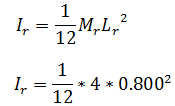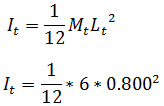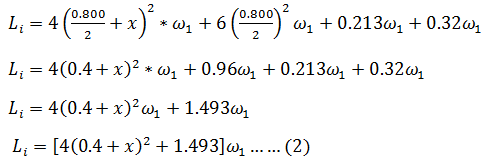800 mm D -x- A -800 mm
Q: is the total kinetic energy of
A: e
Q: 4 A mouse of mass m jumps on a freely rotating disc of moment of inertia I and radius R. If wo and w…
A: From the conservation of angular momentum, I1ω1=I2ω2
Q: Problem ,. The figure below shows a two-dimensional body connected to the ground by two links AB and…
A: First locate the basic instantaneous centers by observation as shown in the figure.(if two links are…
Q: A ball is swung in a circle over the Cheshire Cat’s head before vanishing. If the ball has a mass of…
A: mass , m=0.500 kg radius of circle,r=1.00 m angular velocity,ω=10.0 rad/s
Q: Consider the rectangular block of mass, M = 2Kg and length L = 2m. Two cylindrical disks (each disk…
A: a) Let the initial velocity of the rectangular block be vin, and L be the length of the rod.…
Q: In a double-star system, two stars of mass 3.0 * 10^30 kg each rotate about the system’s center of…
A: Given: Mass of star (m) = m1 = m2 = 3.0×1030 kg. Radius of rotation planet (r) = 1.0×1011 m.
Q: The mass M and moment of inertia C of a thick shell of uniform density p, with internal radius r and…
A: Since we only answer up to 3 sub-parts, we’ll answer the first 3. Please resubmit the question and…
Q: Three identical point masses of m =0.1 (kg) are moving at a constant velocity v =10 (m/s)…
A:
Q: Mars has a mass 0.642 x 1024 kg and a radius of 1700. kg. On average, it is 228 x 106 km from the…
A:
Q: A uniform 1kg disk with a radius of 1 m has a disk drilled out creating a thick-walled ring. Atorque…
A: Given,
Q: Determine the angular momentum of a 74-g particle about the origin of coordinates when the particle…
A:
Q: A thin stick of mass 0.5 kg and length L 0.9 m is attached to the rim of a metal disk of mass M-5.0…
A: Given,Mass of the stick, Length, The mass of the disk, Radius, The potential energy,According to the…
Q: Calculate (a) the rotational inertia of the merry-go-round about its axis of rotation, (b) the…
A: Moment of Inertia The moment of inertia of a rigid body about an axis is the sum of the product of…
Q: In a double-star system, two stars of mass 4.9 x 1030 kg each rotate about the system's center of…
A:
Q: We will assume that the velocity of Juan's hand and the pencil were both 3.6 meters per second prior…
A: Note: “Since you have posted multiple questions, we willprovide the solution only to the first…
Q: A disk rotates about an axis through its center. Point A is located on its rim and point B is…
A:
Q: Suppose the disk has a mass of 50.0 g and an initial velocity of 30.0 m/s when it strikes the stick…
A: The moment of inertia of the disk, I=mr2 The angular velocity, ω=vr
Q: What is the magnitude of angular momentum (in 106 kg.m²/s) of the F-16 at time = 2 s. Assume the…
A: Moment of Inertia The moment of inertia of a rigid body about an axis is defined as the sum of the…
Q: A thin rod of mass M and length L is struck at one end by a ball of clay of mass m, moving with…
A:
Q: Consider an "L-shaped rod” of uniform mass density, hinged at point 'O' is held at rest…
A:
Q: A chain that has a mass of 0.5 kg/m is draped over the sprocket which has a mass of 2 kg and a…
A:
Q: The end point B of a boom is originally 5 m from fixed point A when the driver starts to retract the…
A: The initial distance of the end point B from A is, r0=5 m The radial acceleration is, r¨=-1.0 m/s2…
Q: In a playground, there is a small merry-go-round of radius 4.30 m and mass 150 kg. Its radius of…
A:
Q: In a double-star system, two stars of mass 2.7 x 1030 kg each rotate about the system's center of…
A: mass of each star (m) = 2.7×1030 kg radius (r) = 1.1×1011 m
Q: An object with mass=1.0kg is projected vertically up with speed vo=10 m/s from a point with…
A: Basic Details The change in the angular momentum is the difference between the final and the initial…
Q: Determine the angular momentum Hp of the 4-kg particle about point P.
A: Calculate the perpendicular distance from point P on the line AB. A=2, -1.5, 2B=3, 3, 0P=-1, 1.5,…
Q: ge An arm swings from neutral (0 deg) to 61.3 deg flexion and then back 39.6 deg. Calculate the…
A: Initial angle: 0 degrees (neutral)Flexion angle: 61.3 degreesReturn angle: 39.6 degrees
The 4-kg rod AB can slide freely inside the 6-kg tube. The rod was entirely within the tube (x = = 0) and released with no initial velocity relative to the tube when the

Given:
Mass of the rod AB is Mr=4kg
Mass of the tube CDis Ml=6kg
Angular velocity of the assembly ω1=5rad/sec
X=400mm=0.400m
Length of rod=length of tube=Lr=Lt=800mm=0.800 m
The moment of inertia of the rod is given by,

Ir=0.2133gm2
The moment of inertia of the tube is given by,

It=0.32kgm2
Using conservation of angular momentum,
Initial angular momentum(Li)=final angular momentum(Lf)
Li =Lf ….(1)
The Initial angular momentum of the whole body is given by,


Initially X=0m and ω1=5 rad /sec
So

Li=10.66 kg.m2/s
Similarly, we have to find out final angular momentum Lf.
At x=0.400 m
Equation(2) becomes

Plugging values of Li and Lf in equation (1),
10.66=4.05ω2
ω2=2.632 rad /sec
Step by step
Solved in 3 steps with 12 images

- An 80 kg man stands at the rim of a 100 kg carousel of radius 2.0m initially at rest. He startS +0 waļk along the rim at 1.0 m/s relative to the carousel." What is the angular speed of the carousel ? Treat the carousel as a disk.After all the metal has unwound from the roller, the student measures the radius R and the angular speed wo of the roller to be 25 cm and 20 rad/s respectively. Observed from the side, the roller rotates counterclockwise, as shown. A piece of clay of mass m strikes the very bottom edge of the roller with a horizontal velocity v = 4.0 m/s. The clay sticks to and rotates with the roller. The clay-roller system then rotates with a final angular velocity wi. (f) Is wi greater than, less than, or equal to wo? Justify your answer.= Fn NVIDIA Consider five equal mass objects all with the same non-zero kinetic energy. Unless otherwise stated assume the axis of rotation is through the center-of-mass. Assume all densities are uniform or constant. 4 Order these objects from lowest angular velocity (1) to highest angular velocity (5). A V Type here to search FH alexa ENABLED V 7 Hoop of radius R (axis perpendicular to plane of disk). Solid disk of radius R (axis perpendicular to plane of disk). Solid sphere of radius R. Rod of length 2R (axis perpendicular to rod, axis through END of rod). Rod of length 2R (axis perpendicular to rod). Alt 4 A O 15 Et 1 ال 199+) O IA JU U Le 1 Raining now PE Ctrl = ASUS
- 18-1. Ata given instant the body of mass m has an angular velocity w and its mass center has a velocity vg. Show that its kinetic energy can be represented as T = licw, where Iịc is the moment of inertia of the body determined about the instantaneous axis of zero velocity, located a distance rG|ic from the mass center as shown. IC TGICA star originates as a large body of slowly rotating gas.Because of gravitational attraction, this large body of gas slowly decreases in size.You can assume that no external forces are acting.Which one of the following statements correctly describes what happens as the radius of the body of gas decreases? Both the moment of inertia and the angular velocity increase. Both the angular momentum and the angular velocity increase. The angular momentum increases and the angular velocity decreases. Both the angular momentum and the angular velocity decrease. The angular momentum remains constant and the angular velocity increases.A merry-go-round rotates at the rate of 0.20 rev/s with an 75 kg man standing at a point 2.0 m from the axis of rotation. (a) What is the new angular speed when the man walks to a point 0.6 m from the center? Assume that the merry-go-round is a solid 25 kg cylinder of radius 2.0 m. 5.71 v rad/sec (b) Calculate the change in kinetic energy due to this movement. X J
- The end state of our sun will most likely be a white dwarf star. It would have about one fourth of its current mass and a radius about two percent of its current radius. The Sun today takes 30 days to rotate once about its internal spin axis. This is equivalent to an angular speed of 2.42 x 10-6 rad/s. Its moment of inertia today can be approximated as 3.86 x 1047 kg m². Its final angular speed will be 2.42 x 10-2 rad/s. What would its' final moment of inertia be? Select one: a. b. 1.52 x 10-55 kg m² OC. 6.59 x 1054 kg m² 3.86 x 1051 kg m² 3.86 x 1043 kg m² d.A 2 kg mass is located at r = 2m +3m and has. velocity v = 4 m/s - 1m/s What is the angular momentum of the massA circular disc of mass M and radius R is rotating about its axis with angular speed ω1 . If another stationary disc having radius R/2 and same mass M is droped co-axially on to the rotating disc. Gradually both discs attain constant angular speed ω2. The energy lost in the process is p% of the initial energy. Value of p is
- The center of the cylinder is moving to the left with constant velocity vo. Determine the angular velocity and the angular acceler- ation a of the bar. Neglect the thickness of the bar.You observe a 2.0 kg particle moving at a constant speed of 3.5 m/s in a clockwise direction around a circle of radius 5.0 m. (a) What is its angular momentum about the center of the circle?(b) What is its moment of inertia about an axis through the center of the circle and perpendicular to the plane of the motion?(c) What is the angular velocity of the particle?A satellite in a geosynchronous circular orbit is 42,164.0 km from the center of Earth. A small asteroid collides with the satellite sending it into an elliptical orbit of apogee 45,000.0 km. What is the speed of the satellite at apogee? Assume its angular momentum is conserved.